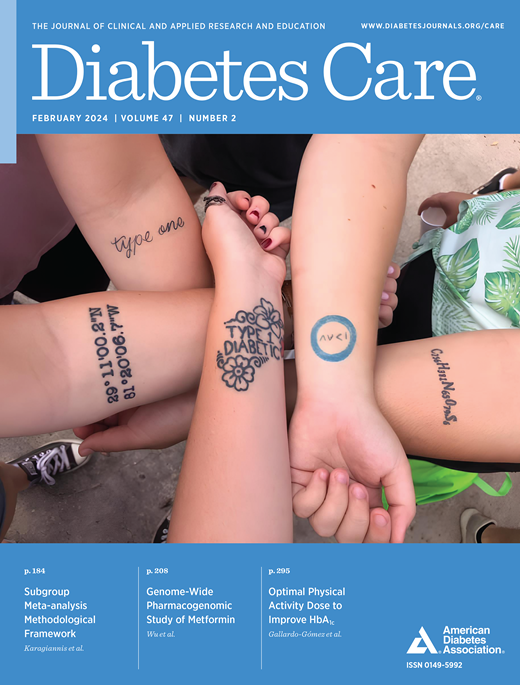Development and Internal Validation of the Multiethnic Type 2 Diabetes Outcomes Model for the U.S. (DOMUS)
IF 16.6
1区 医学
Q1 ENDOCRINOLOGY & METABOLISM
引用次数: 0
Abstract
OBJECTIVE The objective of this study was to develop and internally validate a mathematical model of the relationships between patient clinical and social risk factors and outcomes using data from a multiethnic population with type 2 diabetes. RESEARCH DESIGN AND METHODS We constructed an incidence cohort of all adults (18 years or older) with newly diagnosed type 2 diabetes in the Kaiser Permanente Northern California (KPNC) health care system between 2005 and 2016 (n = 129,000), following patients for at least 1 year, but up to 12 years. Using this cohort, we modeled 17 distinct diabetes-related outcomes related to micro- and macrovascular disease, as well as atrial fibrillation, depression, dementia, relevant biomarkers, and mortality. RESULTS Data were randomly split into 50%, 25%, and 25% samples to perform model estimation, calibration, and validation, respectively. Empirical and simulated data were similar for the events and biomarkers, but some factors required calibration. After calibration, they closely aligned with empirical estimates. CONCLUSIONS The resulting Diabetes Outcome Model of the U.S. (DOMUS) is a major step forward in understanding diabetes progression and the role of social determinants of health. This model can be used by scientists, policymakers, and health system managers to better understand how choices can affect population health and health disparities, including the broad diversity of U.S. races and ethnicities. Moreover, this model can be used to realize longer-term comparative effectiveness in cost-effectiveness analyses for diabetes management in the future.美国多种族2型糖尿病结局模型(DOMUS)的建立和内部验证
本研究的目的是利用多种族2型糖尿病患者的数据,建立并内部验证患者临床和社会风险因素与结局之间关系的数学模型。研究设计和方法我们构建了一个发病率队列,包括2005年至2016年间在北加州凯撒医疗机构(Kaiser Permanente Northern California, KPNC)医疗保健系统中所有新诊断为2型糖尿病的成年人(18岁或以上)(n = 129,000),随访患者至少1年至12年。使用这个队列,我们模拟了17种不同的糖尿病相关结果,这些结果与微血管和大血管疾病有关,以及心房颤动、抑郁、痴呆、相关生物标志物和死亡率。结果数据随机分为50%、25%和25%样本,分别进行模型估计、校正和验证。事件和生物标志物的经验数据和模拟数据相似,但有些因素需要校准。校准后,它们与经验估计密切一致。由此得出的美国糖尿病结局模型(DOMUS)是了解糖尿病进展和健康社会决定因素作用的重要一步。这个模型可以被科学家、政策制定者和卫生系统管理者用来更好地理解选择如何影响人口健康和健康差异,包括美国种族和民族的广泛多样性。此外,该模型可用于实现未来糖尿病管理成本效益分析的长期比较有效性。
本文章由计算机程序翻译,如有差异,请以英文原文为准。
求助全文
约1分钟内获得全文
求助全文
来源期刊

Diabetes Care
医学-内分泌学与代谢
CiteScore
27.80
自引率
4.90%
发文量
449
审稿时长
1 months
期刊介绍:
The journal's overarching mission can be captured by the simple word "Care," reflecting its commitment to enhancing patient well-being. Diabetes Care aims to support better patient care by addressing the comprehensive needs of healthcare professionals dedicated to managing diabetes.
Diabetes Care serves as a valuable resource for healthcare practitioners, aiming to advance knowledge, foster research, and improve diabetes management. The journal publishes original research across various categories, including Clinical Care, Education, Nutrition, Psychosocial Research, Epidemiology, Health Services Research, Emerging Treatments and Technologies, Pathophysiology, Complications, and Cardiovascular and Metabolic Risk. Additionally, Diabetes Care features ADA statements, consensus reports, review articles, letters to the editor, and health/medical news, appealing to a diverse audience of physicians, researchers, psychologists, educators, and other healthcare professionals.
 求助内容:
求助内容: 应助结果提醒方式:
应助结果提醒方式:


